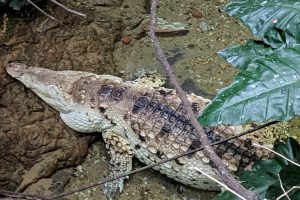27 May
Increased surveillance and joint monitoring can help reduce the level of criminal and insurgent activities along international borders; and bring peace, prosperity and tranquility between two countries while helping in long term conservation of local and regional ecosystems, forests, wildlife and biodiversity.
Some important recommendations suggested for BIMSTEC nations towards collaboration, cooperation, coordination, and communication (4Cs) for successful long term conservation of local forests, wildlife and biodiversity are listed below:
1. Joint Conservation Initiative (JCI) between adjacent member countries sharing international border could make a big difference between short or long term success or complete failure in the process of conservation efforts.
2. Conservation of natural resources could run hand in hand with the development of the local economy. BIMSTEC has huge potential for tourism promotion and development between member countries as the spectacular natural beauty, majestic flora and fauna and improved infrastructure could certainly help in more tourist footfall in these countries helping the economy to be developed steadily over time.
3. A part of the profit could be shared among the local communities and infrastructure development; while the other could be used for the conservation of forest, wildlife and biodiversity. This could be a win-win situation for all as this will make the ecology and economy to be integrated together if planned judiciously and executed carefully with environmental assessment of the local ecosystems regularly and diligently.
4. BIMSTEC platform can boost up the security along the highly vulnerable and unguarded international border areas across land and water between adjacent member nations. Under monitored and porous international borders is an extremely serious issue involving the security of South and South East Asian countries for past several decades; since their independence form the former colonial rulers.
5. The border areas are exploited by insurgents, local goons and criminals, smugglers, drug, human and wildlife traffickers, poachers and several other anti social elements. This should lead to intelligence sharing between the immigration, customs, narcotics and forest departments, intelligence agencies, security forces and border guards on either side of the international border. This will build up better security and trust with the local communities on either side of the border; and help in curbing poaching as well as drug, wildlife and human trafficking.

6. Joint patrolling of the porous border areas by both countries sharing international borders will also help in reduction and prevention of border area crimes (such as adduction, kidnapping, rapes, molestation, extortion and smuggling) successfully.
7. Additional monitoring and surveillance of the densely forested border areas or vast coastal zones by member nation together will reduce incidents of insurgent infiltration, pirates attacking commercial vehicles, poaching of fish and other marine resources by foreign groups in the deep ocean or in the Exclusive Economic Zones (EEZ) could be effectively handled.
8. High powered satellite and drone based aerial surveillance will also help alert member nations regarding potential security threats by insurgents or illegal migrants, traffickers (drug, wildlife and humans), potential natural and/or anthropogenic disasters (cyclones, floods, forest fires, earthquakes, tsunamis etc) in due time for proper management and handling of the situation. This will not only help in the conservation of local and regional forests, wildlife and biodiversity.
9. BIMSTEC can also help in establishing hospitals and medical facilities for the unfortunate remote, rural communities along the sensitive border or frontier areas where very little or no modern health care is available. The development of infrastructure like highways and railway networks, bridges, under passes and freeways, water based transpiration networks, building small, medium and large sized air ports and harbours at suitable places and locations will bring in employment and economic prosperity for the local communities.
10. Together with conventional tourism as well as ecotourism in the forested areas with spectacular natural beauty; there is ample opportunities for both long term and short term economic growth in al the member nations that will get better connectivity with one another over time.
11. The agreements between the member nations can be proactively used for establishing different forestry and wildlife conservation educational and research institutes for building research and development capability of individual member nations for protecting their unique ecosystems. Exchange of technology, expertise, tools and gadgets between member nations will further facilitate the roots of conservation in these countries deep enough to sustain and protect numerous vulnerable and extremely fragile ecosystems located in this region.
12. BIMSTEC platform should be also properly exploited for the purpose of mass education and awareness among the citizens of the member nations regarding the ecological and economical values of the local ecosystems, forests, wildlife and biodiversity in their local languages and dialects. This will help build positive attitude among the mass regarding the need and value of conservation and will also encourage them to come forward in the process as a stakeholder.
13. In addition to several priority centers being built in different member nations to fulfill the target objectives of BIMSTEC; it is important to establish different nature and ecology interpretation centers, wildlife retention and rehabilitation centers too to facilitate conservation.
14. Such an effort will help to build awareness among the citizens for conservation; and will also encourage people to bring in injured or accidentally captured wildlife to the rescue centers for treatment, rehabilitation as well as their release in appropriate wilderness areas. These small efforts if considered cumulatively over a decade will have significant impact in protection of local ecosystems, forests, wildlife and biodiversity.

15. Students at the primary, secondary and tertiary levels of education in BIMSTEC member nations who are the new generation citizens will be particularly benefited by academic visits to such forest, ecosystem, wildlife and biodiversity interpretation as well as wildlife retention and rehabilitation centers through sensitization about ecological and environmental issues.
16. BIMSTEC platform can thus generate a new breed of future conservators, ecologists, foresters, teachers, veterinarians, lawyers, lawmakers and legislators to push forward the conservation agenda for protecting local and regional natural resources and help in promoting Joint Conservation Initiative (JCI) between participating governments by building positive opinion through people to people contact.
17. Thus better transport and communication as well as infrastructural development together with joint monitoring and surveillance will help in the successful conservation of natural resources (forest, wildlife and biodiversity) as well as encourage reforestation (revegetation), afforestation and social forestry practices to bring in additional areas under forestry practices.
18. The latest IPCC report has indicated the rise of global temperature and consequent negative impacts of that on both ecology and economy. BIMSTEC provides an unique platform for member nations to join hands in their efforts protecting, conserving as well as increasing areas under forestry through joint efforts.
19. The BIMSTEC opportunity has significant role to play for the security and conservation of transboundary migrating mammals (elephants, tigers, leopards etc) and migratory birds between different member nations. This platform provides the opportunity to sign treaties and/or agreements in safeguarding mammal and bird migrations corridors and flight paths respectively through proper legal framework supported by respective parliamentary and/or judiciary process. This will secure wildlife that strays across the border and protect them with priority under proper joint legislative umbrella. This could also be easily extended to protect estuarine and marine flora and fauna among member nations that move from the water of one country into another.
20. The process will also help in marking international marine boundaries of member nations where applicable; and will prevent illegal exploitation of marine resources by third part members or by a law violating member nation and help in marine conservation and will also establish peace and tranquility in the Bay of Bengal, the Andaman Sea and the Indian Ocean region.
21. One of BIMSTEC’s major priority objectives has been agriculture and this should be integrated with conservation of ecosystems, forests, wildlife and biodiversity in member nations. All BIMSTEC member nations suffer from some form of political destability and disturbances integrated with slow economic growth and exponential rise of human population putting extra pressure on the carrying capacity of their local natural ecosystems and environments.
22. Due to economic backwardness people settled in and around forested areas are heavily dependent on the local forest for their sustenance as well as livelihood. This heavy anthropogenic footprint on the local ecosystems is steadily depleting local forest of major and minor forest resources. Due to absence of ay organized poultry, cattle and libestock people are depended on the availability of bush meat as a cheap and significant source of their daily need for protein. This has been depleting local wildlife in several parts of BIMSTEC nations and need to be controlled urgently.
23. Agricultural development in such areas and within such communities will certainly help reducing their heavy dependence on local forests for sustenance and livelihood; as agriculture will provide both food and employment for many of the marginal communities living in remote forested areas of the BIMSTEC member nations. This could a new imitative in integrating ecology and economy together.
24. Another important opportunity that can lead from this BIMSTEC platform is the exchange of related species and sub species between similar ecosystems and habitats across different member nations. There are strong similarities of species habitats across South and South East Asia. Many species had wide distribution across the region historically; but has now been restricted to distinct habitats within particular country due to numerous natural and anthropogenic factors. For example avian species like blue peafowl (popularly called peacocks) and antelope like blue bulls have now got wide distribution and substantially large populations in India due to successful conservation practices. Their numbers have increased to such an extent that in many Indian states these two species have become pests for standing crops. Some state governments in India even went to this extent of culling these species by shooting them to bring their population under control! It gave rise to huge controversy and resulted in strong human-animal conflicts. Neighbouring Bangladesh however had these two species becoming extinct in the wild in the past. Through BIMSTEC platform excess species could be relocated to suitable habitats in Bangladesh and help bringing back lost species to s historical range rather them killing them mercilessly.
25. Another good example is green peafowl that is currently found in the wild only in certain pockets of old forests in South East Asia like Myanmar and Thailand. At one point of time green peafowls were found commonly across various states in North East India. But due to over hunting, illegal capture and habitat lost; the species has become extinct in India. Through BIMSTEC platform breeding pairs could be imported from South East Asia to reintroduce and re-establish the beautiful green peafowl once again across their historic North East India habitats.
26. Gharials have become extinct from most parts of South and South East Asia; with last breeding populations surviving in Nepal and India only. But successful captive breeding programs and relocation in suitable wild habitats across Bhutan, Bangladesh, Myanmar and Sri Lanka could be achieved through exchange of breeding pairs and introducing them to ideal habitats in older range of the species following proper conservation management and constant surveillance and monitoring.
27. Similar captive breeding programs for pangolins, red panda, Indo-Chinese tiger, Indo-Chinese leopard, snow leopard, clouded leopard, Asiatic lions, one horned Indian rhinoceros, Asiatic elephants, river dolphins, dancing deer, gaur, bears, sloths, gibbons, various species monkeys and endangered raptors and vultures with trans border distribution could be practiced under BIMSTEC agreement to reintroduce species to their old range of distribution through legal exchange of breeding pairs and captive breeding and reintroduction approach. Numerous such other examples could be cited that could be made a reality by using the BIMSTEC cooperation and agreements between member nations.
28. Recently there have been numerous reports across South Asia and South East Asia regarding over crowding of certain species that needs relocation and redistribution in other open habitats for their healthy and sustainable growth and to avoid any unwanted genetic bottlenecks. Furthermore, overcrowding of a dominant species in one single habitat also runs the risk of unexpected extermination through the dissemination of contagious diseases or due to any natural and/or anthropogenic disturbances such as draught ad flooding, earthquake or massive forest fires.
29. For example the high concentration of Asiatic lions in the Gir Sanctuary in the western Indian state of Gujarat or one horned Indian rhinoceros in the Kaziranga Biosphere Reserve in Assam in north east India and Chitwan Reserve Park in Nepal or Royal Bengal tigers and Asiatic elephants in western, central and southern Indian, Nepal and Bhutan wildlife sanctuaries and reserved forests can be cited as examples. BIMSTEC platform could help member nations to share this over crowding in related suitable habitats in adjacent countries having similar species and quality habitats.
30. Wildlife retention and rehabilitation centers could serve as another important objective through the BIMSTEC platform. In one hand they will serve as a treatment and rehabilitation centers for injured or captured or recovered wildlife species before their release into their natural habitats. On the other hand they will serve as an important center for training and education of young and budding conservators, ecologists, foresters, wildlife veterinarians, animal care specialists and experts under the supervision of local, regional and international experts. Such institutes could serve as an important resource of protecting and recovering local wildlife once they accidentally move into human habitation/settlement adjoining forested areas or are recovered by customs department from poachers and wildlife traffickers trying to illegally transport animals and other forest resources across the international border.
31. Wildlife and conservation biologists, foresters, ecologists and other experts from the seven BIMSTEC member nations should have access to easily visit the forests, sanctuaries, biosphere reserves, protected areas and national forests and parks, zoological and botanical gardens and museums in adjoining countries for the purpose of research and development, education and training as well as for sharing their expertise and valuable field level experiences with one another for enriching their conservation experience and training.
32. Yearly evaluation of the status of the forest, wildlife and biodiversity in the BIMSTEC nations needs to be released following comprehensive surveys.
33. Yearly or bi yearly meeting of conservation experts should also take place regularly by rotation in seven member nations. Valuable lessons learnt should be shared and discussed among members.
34. Technological exchanges between member nations related to forest, wildlife and biodiversity protection and conservation would provide a big boost towards success of conservation in South and South East Asia.
35. A BIMSTEC high powered steering committee should be formed with members form seven nations that would provide updates and progress to their respective parliamentary member in a regular manner.
By S. K. BASU


